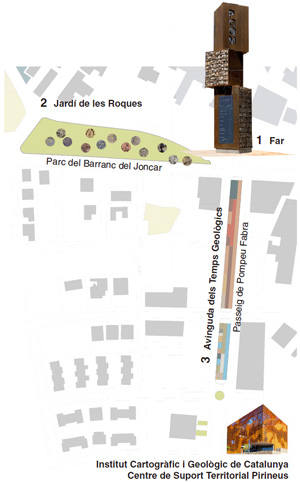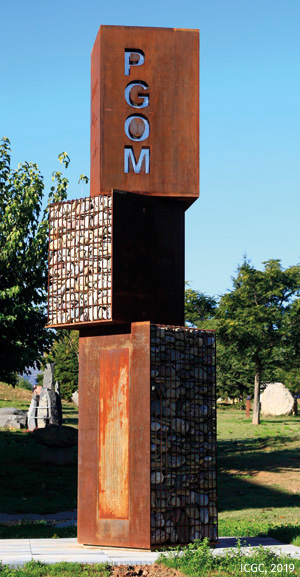The tour
The exhibition consists of three areas:
• The Lighthouse, a unique tower made of steel and rocks, located at the intersection of the Rock Garden and Avenue of the Geological Times, which indicates the starting point of the visit to the geological complex.
• The Rock Garden, located in the Barranco del Joncar Park, where different types of rock blocks from the Pyrenees meet.
• the Avenue of the Geological Times, located on the Paseo de Pompeu Fabra, where the evolution of the Earth and of life is shown on the pavement built with different natural and artificial materials.
See PGOM location (Tremp)
The Lighthouse
The Lighthouse is the starting point of the visit to the Pirineus Geological Open Museum and is located at the intersection between the Paseo de Pompeu Fabra (Avenue of the Geological Times) and the Parque del Joncar (Garden of the Rocks), being the element that unites the two exhibition areas.
It is a tower formed by elements of patinated steel sheet allied to copper, 6 meters high. Contains the label of the entire installation and information on the exhibition route.
This tower includes three cubicles or gabions filled with dry stone; it contains lighting equipment so that the representative landmark of the exhibition remains visible at night through the dim light that filters through the dry stone.
The design and materials of the tower continue the architecture of the ICGC Center de Suport Territorial Pirineus building, which is located at the other end of the Paseo.
Garden of Rocks
From the Lighthouse we head to the Garden of Rocks, the first area of the visit, where 13 representative rock blocks of the Pyrenees corresponding to specific periods of the International Table of Geological Times are exposed. The stands in front of the blocks provide basic information on each type of rock.

The thirteen blocks numbered from 1 (the most modern) to 13 (the oldest) draw a discovery itinerary
To the west of the lighthouse, in the Parque del Barranco del Joncar we find the Garden of Rocks, perpendicular to the Avenida de los Tiempos Geológicos. 13 representative rock blocks of geological materials from the Pyrenees that have been contributed by companies associated with the Arid Guild of Catalonia and also by municipalities and individuals are exposed. They correspond to specific periods of the International Table of Geological Times. They are distributed throughout the Park in such a way that they describe an itinerary that begins with the most modern block of materials and ends with the oldest block of materials.
The lecterns located next to each of the large blocks provide basic information on the most representative types of rocks in the Pyrenees
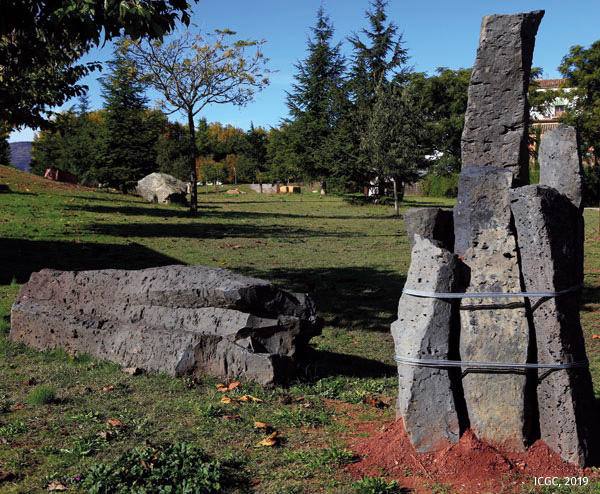
Exemple 2. Basalt (St. Joan les Fonts). Acknowledgments: Sant Joan les Fonts Council and the Arid Guild of Catalonia
Avenue of the Geological Times
The Avenue of the Geological Times, located on the Paseo de Pompeu Fabra de Tremp perpendicular to the Jardin de las Rocas, presents an interpretation of the International Table of Geological Times whose length has been adapted to the length of each section of the Paseo.
As we walk from the northern part of the Paseo to the southern part, through the texts and symbols we are shown the passage of time, from the formation of the Earth until now and the evolution of life during 4.6 billion of years that covers the entire history of Earth (from the Haddic to the Quaternary).
On the pavement of the Paseo the first three levels of the Table are represented in colors: Eonotem / Eon, Eratem / Era and System / Period and engraved above is the name of each period and the most relevant marks of each (the formation of the Moon, the disappearance of dinosaurs, the appearance of insects, the first humans, etc.).
In informative lecterns we find the texts that facilitate the visit and help interpret the International Table of Geological Times.
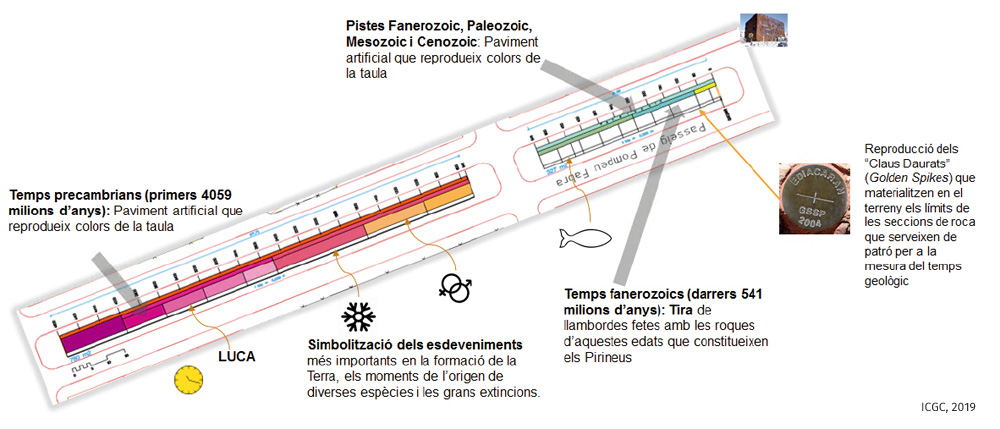
The Avenue of the Geological Times
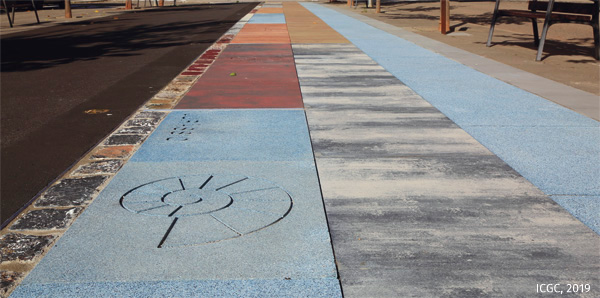
Section of the walk where the great abundance of Ammonites in the Jurassic is indicated
The objective of the PGOM is to provide students and the general public with the simplest and most playful way possible, some basic geology concepts related to the evolution of the Earth and of life and the typology of representative rocks of the Pyrenees.
The outdoor exhibition completes the geological complex of the area that concentrates in a few square kilometers a first-rate natural laboratory of geological, mining, paleontological and cultural scope and where the Department of Territory and Sustainability through the Cartographic and Geological Institute of Catalonia It has the headquarters of the Pyrenees Territorial Support Center.
The Pirineus Geological Open Museum is a reality as a result of the collaboration agreement number 164 signed on June 14, 2016 between the Tremp City Council and the ICGC, and thanks to the contributions of the Arid Guild of Catalonia and associated companies, municipalities and individuals that rocks and building materials have been yielded without which it would not have been possible to carry out this project.
The references of the Garden of Rocks can be found on the campus of the British Geological Survey, in Nottingham, United Kingdom::
(https://www.bgs.ac.uk/contacts/sites/keyworth/geologicalWalk/home.html)
and in the Giardino Geologico Museum "Sandra Forni", in the urban surroundings of the Servizio Geologico, Sismico e dei Suoli della Regione Emilia-Romagna, in Bologna, Italy:
(https://ambiente.regione.emilia-romagna.it/it/geologia/museo-giardino-geologico)
where the rock blocks were loaned respectively by British and Italian stone industries.
The Avenue of the Geological Times has two partial references:
- One is the cobblestone pavement of the British Geological Survey campus,
- The other is the temporary exhibition organized in 2009 at the Ciudadela Park by the then Geological Institute of Catalonia on the occasion of the International Year of Planet Earth, along with other institutions. Adapted, by agreement, with content from the Muséum national d'Histoire naturelle de Paris..
Sponsors
Associated companies of the Arid Guild of Catalonia
Public and private entities
Sant Joan les Fonts City Council, Tremp City Council, Decentralized Municipal Entity of Guàrdia d’Ares (Valls d’Aguilar City Council), Antonio Monsó Fillat, Fina Pallise Figuerola, Josep Tarrats Piqué
Promoter

 Contact
Contact








